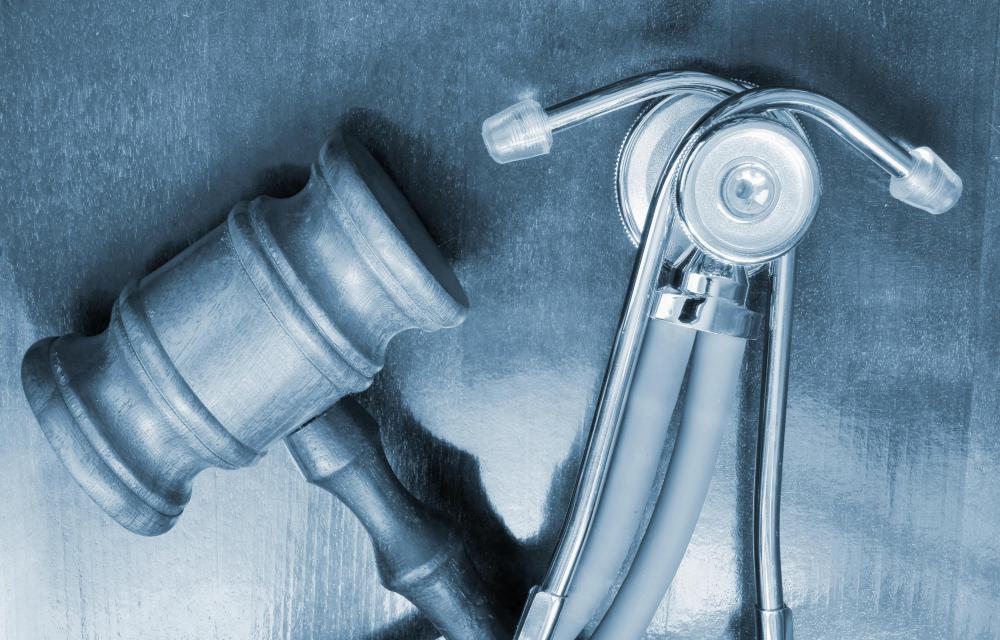At WiseGEEK, we're committed to delivering accurate, trustworthy information. Our expert-authored content is rigorously fact-checked and sourced from credible authorities. Discover how we uphold the highest standards in providing you with reliable knowledge.
What are the Key Medical Malpractice Cases?
The tort of medical malpractice is generally defined in law as a form of professional negligence in which a patient suffers harm because a health care provider violated accepted standards of medical practice. Precisely what this entails, and how an accusation of malpractice can be proved in court, has evolved over time as the result of precedents from previous cases. In nations with legal systems that have their foundations in British common law, such as the United States of America and the United Kingdom, cases that set important precedents applied in medical malpractice cases include Bolam v. Friern Hospital Management Committee, Frye v. United States, and Daubert v. Merrell Dow Pharmaceuticals.
The plaintiff in Bolam v. Friern Hospital Management Committee was a resident of a British mental institution who underwent electroconvulsive therapy. He suffered injuries owing to the uncontrolled convulsions of his body during the procedure and sued Friern for negligence for failing to restrain him or administer relaxant drugs during the procedure and for failing to warn him about the risks the procedure entailed. The jury found in favor of the defendant.

In his written opinion, Judge Justice McNair laid out the standard that has subsequently become known as the Bolam test, commonly used as part of the requirements for an act to be defined as negligent. Under this standard, a medical professional is negligent if he or she does not act in accord with practices regarded as legitimate by a "responsible body of medical men.” Though originating in Britain, the Bolam test is used in medical malpractice cases in the United States as well.

This responsible body does not need to be a majority. A minority is acceptable, provided that this minority is composed of professionals regarded as legitimate within their field. For example, a surgeon who treated a particular type of injury with a different procedure than most of his or her colleagues is not guilty of negligence if there is a minority of legitimate surgeons who agree with his or her dissenting view about the best treatment. On the other hand, a surgeon who performed surgery while wearing soiled gloves would be negligent, because no respectable surgeon would consider that acceptable or responsible.

Medical malpractice cases frequently involve disputes over specialized issues beyond the knowledge of the average layperson. As a result, they often involve an expert witness who provides the jury with information about medical science and practice. In the United States, the most influential precedents concerning expert testimony are Frye v. United States in 1923 and Daubert v. Merrell Dow Pharmaceuticals in 1993.

Frye's case itself did not involve medical malpractice, but the precedent it set would be essential to medical malpractice cases for the next 70 years. James Frye was put on trial for murder after confessing to the police. Frye subsequently withdrew his confession, but could not substantiate his alibi. Frye's attorney attempted to submit as evidence the results of a lie detector test that ostensibly proved Frye's truthfulness. This was denied by the judge, and Frye was convicted of second-degree murder. Frye's attorney appealed, claiming that legitimate evidence had been wrongly excluded, but the decision was upheld on appeal.

Judge Van Orsdel of the District of Columbia's Circuit Court of Appeals wrote an opinion laying out what would subsequently be called the Frye standard. Excluding the lie detector test was proper, Orsdel wrote, because the lie detector's alleged abilities were not widely accepted as valid or reliable by experts in relevant scientific fields. This made it unsuitable for use as evidence in a court room.
The Frye standard has been replaced in federal courts and most state courts by the Daubert standard, named after the medical malpractice case Daubert v. Merrell Dow Pharmaceuticals. The plaintiffs were a group of people with birth defects, along with their parents, who sued Merrell Dow Pharmaceuticals on the grounds that the birth defects were caused by a Merrell Dow product. The plaintiffs submitted scientific evidence that they said supported their claim. Merrell Dow countered that the scientific studies submitted by the plaintiffs were the product of methods that were not widely accepted among scientists, resulting in a summary judgment in favor of the defendant. The case was appealed and eventually went before the United States Supreme Court.
The plaintiffs argued that the Federal Rules of Evidence, legislation passed in 1975, had supplanted the standard set in Frye. The Federal Rules of Evidence stated that a witness called to give expert testimony was required to be qualified as an expert by his or her education, experience, or knowledge. These rules did not, however, require that such testimony be in accord with generally accepted scientific opinion. The Supreme Court agreed, overturning the decisions of the lower courts and establishing the Daubert standard for the admissibility of scientific testimony.
AS FEATURED ON:
AS FEATURED ON:















Discuss this Article
Post your comments